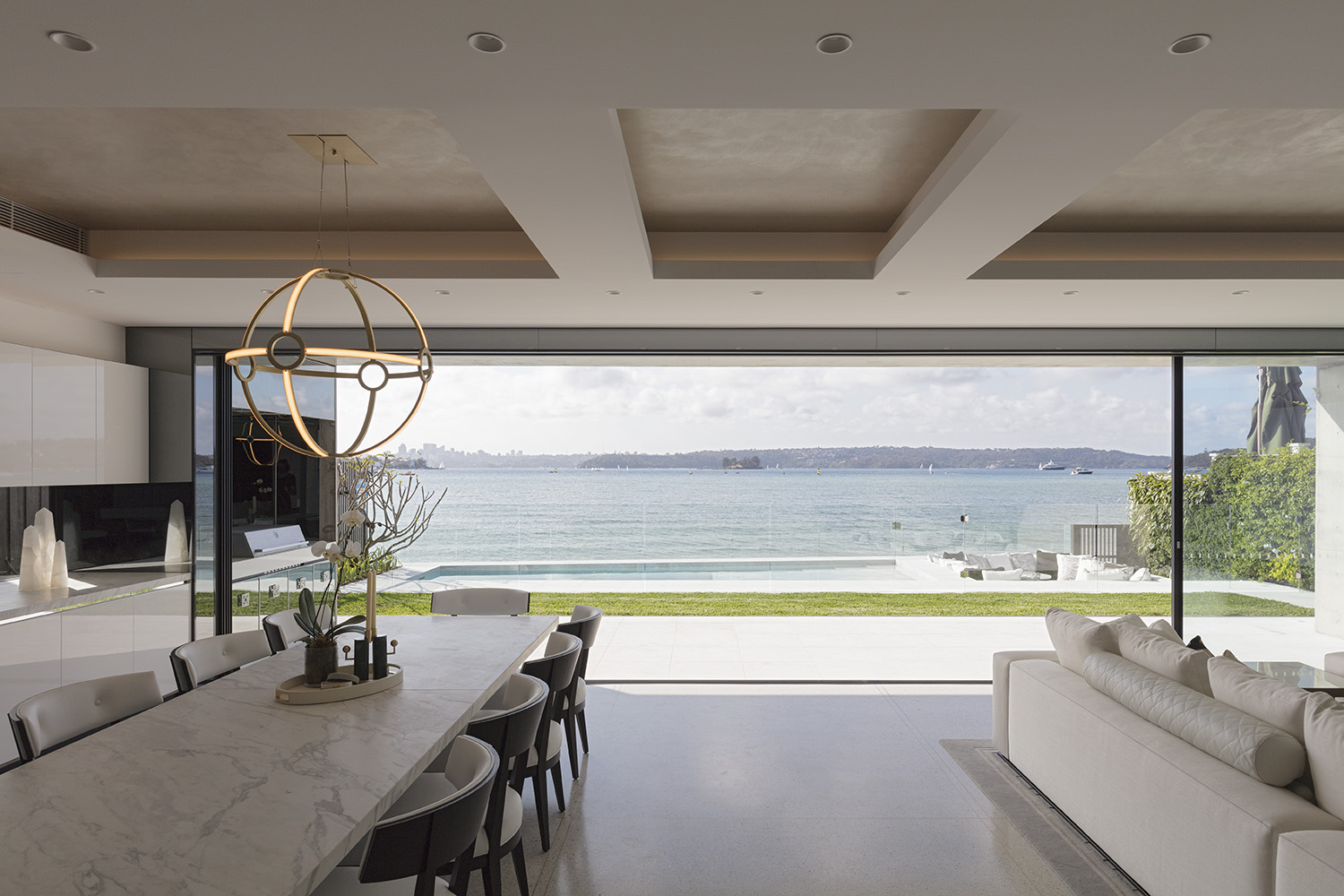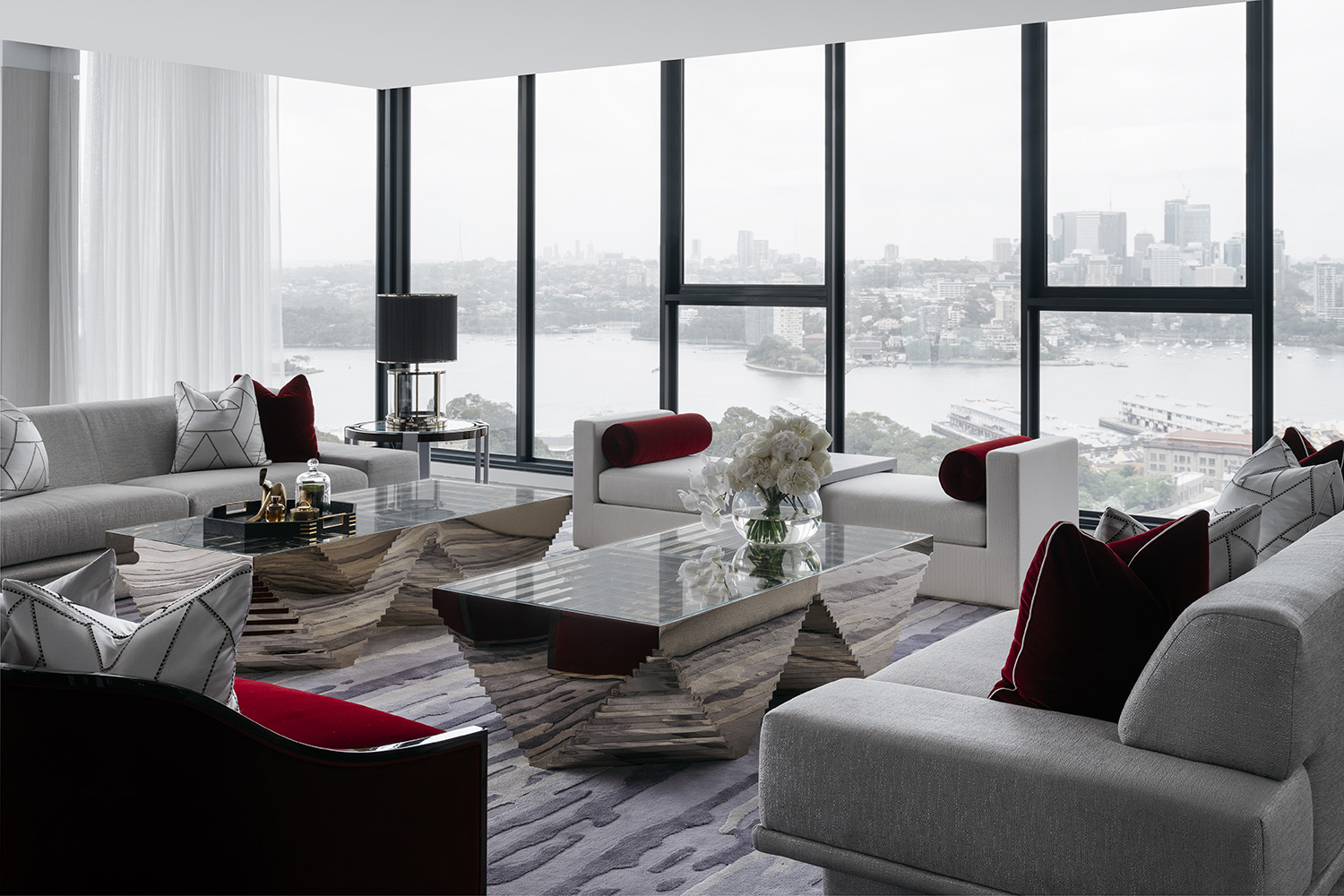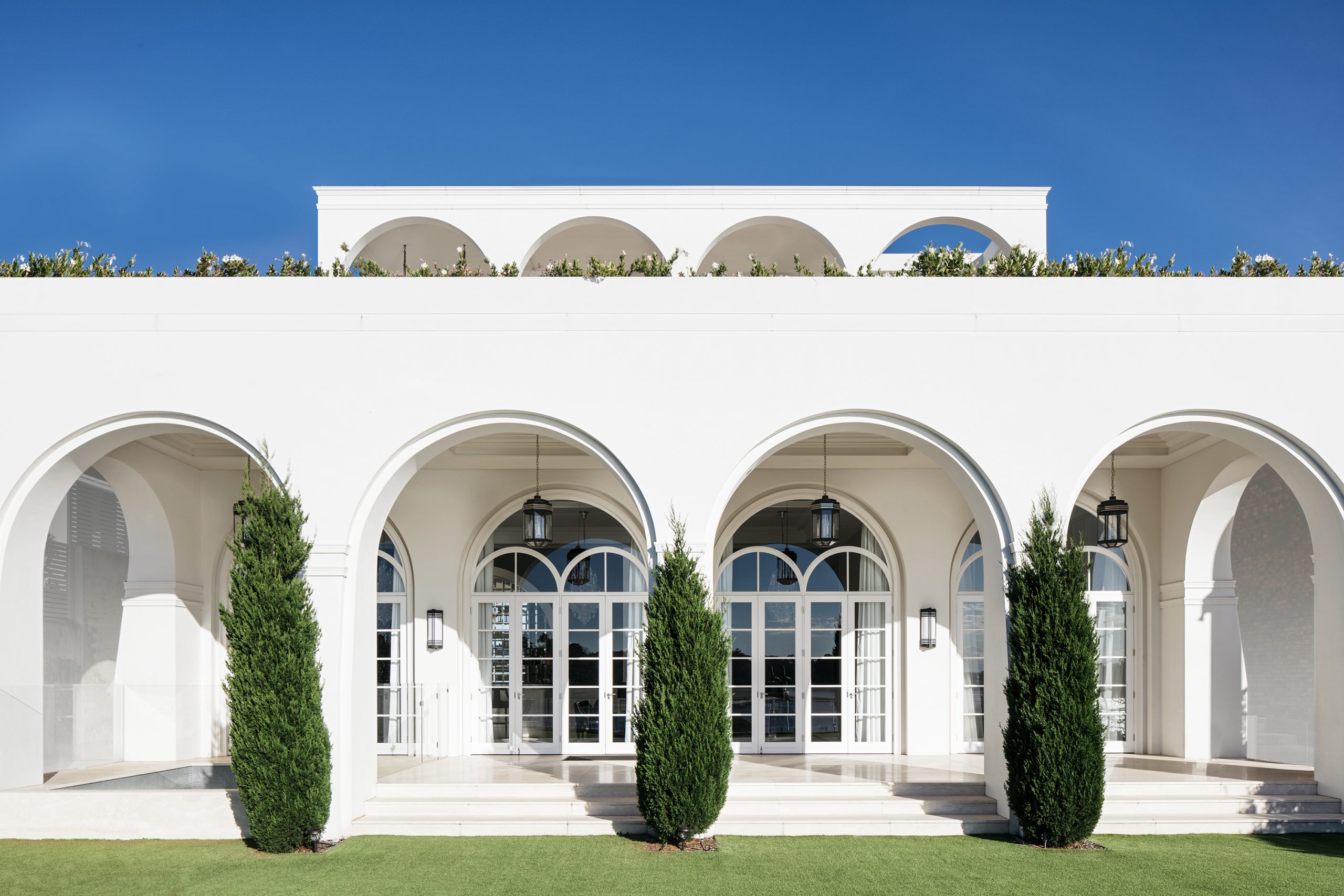Interview: Blainey North, Architect / Interior Designer
Post-COVID interiors and why trends are little more than “background noise.”
Post-COVID interiors and why trends are little more than “background noise.”
Blainey North’s surname fits well – the ebullient Sydneysider and enviable multitasker on an upward trajectory like few others.
Architect, interior and industrial designer, entrepreneur, business leader and firm Australian success story, North is a standout, having launched her eponymous studio at 21 and pushed hard to achieve ever since.
It’s meant working across a swathe of differing projects, from luxury Australian residences to hotels (Crown Towers and Metropol but two), megayachts (the 54m Mischief), restaurants (Bistro Guillaume) to the world’s tallest residential tower (New York’s Central Park Tower) and more.
We caught up to talk Bladerunner, ‘Zoom walls’ and gender neutrality in design.
Kanebridge News: So much of your work is framed by a sense of architectural allure – which perhaps isn’t surprising as this was your chosen field of study, right?
Blainey North: Yes, I studied architecture and always approach our projects with an eye focusing on the built elements before I even look at the interior decoration. I believe interiors should be crafted with the walls, ceilings and floors becoming part of the consideration in shaping the idea.
KN: Does having such greatly assist in your design process and also your industrial design work with the various Blainey North Collection pieces?
BN: The rigour in designing a piece of furniture is the same as that of a building, it’s just a set of entirely different problems to solve. I love the freedom of designing the furniture and lighting pieces as they are like beautiful little jewels that I can design without any client in mind. It’s a lovely artistic outlet for me. The latest collection, titled Man and the Machine was inspired by my deep fascination with the city and a bodies movement through it. It was almost an indulgence to be able to think and craft pieces based on a particular area of my interest.
KN: It’s arguably strange that more interior designers don’t produce their own pieces – what do you see as the main barriers to overcome here?
BN: To produce and manufacture something is far more involved than anyone would imagine. The design part is actually only a small fraction of what is required as the process of trial and error in prototyping, finding the right people to build it with you, the cost and the labour are all enormous factors in being able to produce a product of excellent quality. That’s all before you have a sale. I’m incredibly proud of our furniture and lighting collection, however it is a very distinct business to the interiors.

KN: How has COVID impacted or brought change to the way you approach (indeed, clients are wanting you to approach) certain aspects of residential interiors and spaces?
BN: People are again ‘living’ in their homes. By that I mean, they’re entertaining and spending time in and about the house. It’s similar to the1800’s in that respect, and so too there’s a desire for a similar traditional house layout — where the kitchen and the ‘working”’ parts of a house are separated from the entertaining. And so we’re designing homes again with butlers pantries and stand alone kitchens, formal dining rooms, formal lounge areas. It’s a return to the past… Oh, and we’re also being asked to design specific walls for people’s Zoom background, which is quite fun.
KN: Is there a preference when it comes to interiors — in regards to residential over, say, large scale ‘commercial’ efforts?
BN: I absolutely love working at a large scale – there’s a rush about building something that’s so much larger than you. We’re interestingly seeing a trend where homes and apartments are becoming far bigger, in both Australia and the rest of the world. Many of the homes and apartments we’re working on are over 2000sqm internal… Frankly, though, I love all forms of design and select the projects we take on based on whether I feel inspired by the brief and have a nice synergy with the client.
KN: I recall a want to make every project ‘magazine worthy’ — can you explain this philosophy?
BN: Many design firms work on a model of designing a large number of projects with simple design and then take on a few special projects that they put extra time and energy into ( they might make a loss on these). My dream was to create a business where the everyday design process in the studio was so rigorous that every project was a project you were proud to show. It’s been a huge decision as it’s meant that financially you take a long term vision. However, right now, 20 years in, it’s meant we have a large body of work that we can stand behind and have so many repeat clients that we’ve worked with for over 15 years now.

KN: You don’t present, through your work and also on a personal level, as someone who necessarily follows or adheres to trends. Fair to say there’s a Blainey North narrative and that’s your focus?
BN: I do spend a lot of time researching and looking at what is current and new, however I’ve always been a lone wolf. Emulating trends in design is just background noise in my opinion. I believe that original design comes from a different place and a unique process, something we like to work with the client on. I like to think of every project being a grand scale couture dress – it’s designed and made just for you.
KN: If you did have to target some likely design trends to appear this year and across 2022 – what can people expect?
BN: Detail and craft – it’s like the 1920’s all over again. The world is coming out of a period of minimalism and great pain and we’re ready to celebrate again and see beauty in all aspects of our life. I think that will mean that creativity will flourish in all areas of the arts with a specific focus on our interior spaces, the ones we have spent so much of the year inhabiting. It’s an incredibly exciting time to be in my field.
KN: In regards to your aesthetics there’s often a sense of moody and arguable masculinity to some of the work — fair summation?
BN: I’ve always found this idea of gender based aesthetic so curious, I mean, what does it mean to have a male or female aesthetic? If it’s floral and curved should that mean it’s feminine? I can say that I attempt to be original in detail and concept in each of our projects, and bring that rigour to the detail as well. I think it’s that attention to detail and alignment that is similar to the principles of Art Deco.
KN: Where do you find inspiration — is much of it delivered, simply, by the everyday and all that surrounds you in Sydney?
BN: I’m usually researching something in my spare time — for example, I’m currently interested in the direction of Kris Van Assche, the creative director of Berluti. In his latest collection he’s been fusing the art of a particular ceramicist and morphing it into fashion in a way I haven’t seen before. It’s started me thinking about how I might use this same technique and apply it to our architecture and interiors. I’m sure that our next project will have some of this inspiration coming from the art world.

KN: Are Australians — generally speaking — becoming braver and bolder with their approach to interior and architectural design?
BN: I think there is a new appreciation for design as a whole. Australia has now seen that good design might be more expensive in the short term, but it can deliver financially in the long term. That means that the developers are enthusiastic about building good design and understand that can relate to better sales and longevity in the product.
KN: Do you feel international markets are increasingly looking enviously at the contemporary design aesthetics we’ve developed here — especially in relation to open interiors, use of light, airiness and so on?
BN: Absolutely, we have such a unique set of criteria here with intense light and an amazing climate, we’ve developed amazing solutions to the indoor/ outdoor transition.
KN: Crown Spa Sydney is a recent project of yours – can you talk us through the concept here and what you were wanting to achieve. And your take on the Chris Wilkinson-designed building itself, from an architectural standpoint?
BN: We wanted the spa to feel like the moment you start drifting off to sleep, that space between sleeping and waking where your peripheral vision blurs. I think that’s one of the most beautiful and relaxing moments in a day, when the mind stops before it goes into a dream state. The design is full of curves and semi transparent walls of resin that you slip around. We worked with Hayden Cox, the famous Sydney surfboard shaper to create these unusual tables and benches in organic surfboard like shapes. It’s lovely as it feels incredibly relaxing but also somewhat unusual — a space which flows and you can’t quite put your finger on.
As for the buildng, it’s our greatest piece of architecture second only to the Sydney Opera House. It was an incredible feat to be able to build a tower which is twisting in three directions. There isn’t a straight wall on the whole façade which meant it was a challenging project for all the team involved. The documentation required complex spacial thinking and resolution. I’m so proud to have worked on the project — it’s rare that such an architectural vision is executed at this level of quality.
KN: What are your other artistic pursuits beyond design?
BN: One could argue I’ve made an art out of dining out. However I do spend time going to galleries and I’m a patron of the Sydney Film Festival. I really love film and find film sets of great inspiration for our work. In fact, one of our designs had wall panels inspired by the set of the movie Bladerunner.
KN: Name three timeless pieces every home needs and a simple sentence as to why?
BN:
KN: What projects are exciting you most in regards to the year ahead — those which you can discuss?
BN: We are so excited to be finishing the apartments in Central Park Tower, the tallest residential tower in the world and which is on Central Park in Manhattan. It’s been an amazing challenge to build during Covid, however, we’ve created some amazing new systems to work with our clients and offices internationally. We’re presenting more and more in virtual reality, where I can walk the client and the team through the design in real time on the computer.
What a quarter-million dollars gets you in the western capital.
Alexandre de Betak and his wife are focusing on their most personal project yet.
As Paris makes its final preparations for the Olympic games, its residents are busy with their own—packing their suitcases, confirming their reservations, and getting out of town.
Worried about the hordes of crowds and overall chaos the Olympics could bring, Parisians are fleeing the city in droves and inundating resort cities around the country. Hotels and holiday rentals in some of France’s most popular vacation destinations—from the French Riviera in the south to the beaches of Normandy in the north—say they are expecting massive crowds this year in advance of the Olympics. The games will run from July 26-Aug. 1.
“It’s already a major holiday season for us, and beyond that, we have the Olympics,” says Stéphane Personeni, general manager of the Lily of the Valley hotel in Saint Tropez. “People began booking early this year.”
Personeni’s hotel typically has no issues filling its rooms each summer—by May of each year, the luxury hotel typically finds itself completely booked out for the months of July and August. But this year, the 53-room hotel began filling up for summer reservations in February.
“We told our regular guests that everything—hotels, apartments, villas—are going to be hard to find this summer,” Personeni says. His neighbours around Saint Tropez say they’re similarly booked up.
As of March, the online marketplace Gens de Confiance (“Trusted People”), saw a 50% increase in reservations from Parisians seeking vacation rentals outside the capital during the Olympics.
Already, August is a popular vacation time for the French. With a minimum of five weeks of vacation mandated by law, many decide to take the entire month off, renting out villas in beachside destinations for longer periods.
But beyond the typical August travel, the Olympics are having a real impact, says Bertille Marchal, a spokesperson for Gens de Confiance.
“We’ve seen nearly three times more reservations for the dates of the Olympics than the following two weeks,” Marchal says. “The increase is definitely linked to the Olympic Games.”

According to the site, the most sought-out vacation destinations are Morbihan and Loire-Atlantique, a seaside region in the northwest; le Var, a coastal area within the southeast of France along the Côte d’Azur; and the island of Corsica in the Mediterranean.
Meanwhile, the Olympics haven’t necessarily been a boon to foreign tourism in the country. Many tourists who might have otherwise come to France are avoiding it this year in favour of other European capitals. In Paris, demand for stays at high-end hotels has collapsed, with bookings down 50% in July compared to last year, according to UMIH Prestige, which represents hotels charging at least €800 ($865) a night for rooms.
Earlier this year, high-end restaurants and concierges said the Olympics might even be an opportunity to score a hard-get-seat at the city’s fine dining.
In the Occitanie region in southwest France, the overall number of reservations this summer hasn’t changed much from last year, says Vincent Gare, president of the regional tourism committee there.
“But looking further at the numbers, we do see an increase in the clientele coming from the Paris region,” Gare told Le Figaro, noting that the increase in reservations has fallen directly on the dates of the Olympic games.
Michel Barré, a retiree living in Paris’s Le Marais neighbourhood, is one of those opting for the beach rather than the opening ceremony. In January, he booked a stay in Normandy for two weeks.
“Even though it’s a major European capital, Paris is still a small city—it’s a massive effort to host all of these events,” Barré says. “The Olympics are going to be a mess.”
More than anything, he just wants some calm after an event-filled summer in Paris, which just before the Olympics experienced the drama of a snap election called by Macron.
“It’s been a hectic summer here,” he says.

Parisians—Barré included—feel that the city, by over-catering to its tourists, is driving out many residents.
Parts of the Seine—usually one of the most popular summertime hangout spots —have been closed off for weeks as the city installs bleachers and Olympics signage. In certain neighbourhoods, residents will need to scan a QR code with police to access their own apartments. And from the Olympics to Sept. 8, Paris is nearly doubling the price of transit tickets from €2.15 to €4 per ride.
The city’s clear willingness to capitalise on its tourists has motivated some residents to do the same. In March, the number of active Airbnb listings in Paris reached an all-time high as hosts rushed to list their apartments. Listings grew 40% from the same time last year, according to the company.
With their regular clients taking off, Parisian restaurants and merchants are complaining that business is down.
“Are there any Parisians left in Paris?” Alaine Fontaine, president of the restaurant industry association, told the radio station Franceinfo on Sunday. “For the last three weeks, there haven’t been any here.”
Still, for all the talk of those leaving, there are plenty who have decided to stick around.
Jay Swanson, an American expat and YouTuber, can’t imagine leaving during the Olympics—he secured his tickets to see ping pong and volleyball last year. He’s also less concerned about the crowds and road closures than others, having just put together a series of videos explaining how to navigate Paris during the games.
“It’s been 100 years since the Games came to Paris; when else will we get a chance to host the world like this?” Swanson says. “So many Parisians are leaving and tourism is down, so not only will it be quiet but the only people left will be here for a party.”